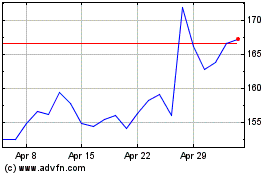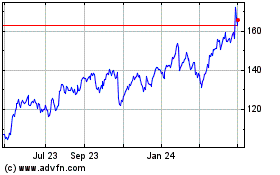By Jeffrey A. Trachtenberg
This article is being republished as part of our daily
reproduction of WSJ.com articles that also appeared in the U.S.
print edition of The Wall Street Journal (January 24, 2019).
Magazine publisher Condé Nast said it would put all its titles
behind paywalls by the end of the year, as pressure builds on major
publishers to generate more revenue beyond advertising.
Three Condé Nast titles, the New Yorker, Vanity Fair and Wired,
already are behind metered paywalls that require consumers to
subscribe in order to access more than four articles each month.
Now, the company plans to build digital subscription businesses
around its other titles, including Vogue, GQ, Bon Appétit and
Glamour.
More publishers, from news outlets to digital-media specialists
to magazines, are turning to paywalls in response to challenges in
their businesses.
Condé Nast is searching for ways to revive its growth, as print
advertising continues to fade and as competing for digital ad
dollars against titans like Alphabet Inc.'s Google and Facebook
Inc. is proving tough. Paywalls are a key element of its turnaround
plans.
"When you put a price tag on something, that must mean you have
confidence in the product," said Pamela Drucker Mann, Condé Nast's
chief revenue and marketing officer, who pushed for the paywalls.
She said she didn't expect any of the titles going behind a metered
paywall to lose digital audiences.
The iconic publisher, a unit of closely held Advance
Publications Inc., lost $120 million in 2017, but aims to return to
profitability by 2020. Condé Nast chief Bob Sauerberg has said the
company expects to rely on advertising for only half of its revenue
by the end of 2022, down from 70% last year.
The company said in November that Mr. Sauerberg will step down
from his position after a new global chief executive is named to
oversee both Condé Nast and Condé Nast International. A search is
under way.
The Atlantic, Business Insider and New York Magazine-parent New
York Media, are among the many publishers that have moved toward
charging for digital subscriptions, following publishers like the
The Wall Street Journal and the New York Times that put up
paywalls. Other outlets, like BuzzFeed, have launched membership
programs to collect donations.
Not all publishers are convinced. Meredith Corp., which
publishes such titles as People, Better Homes & Gardens, and
the Magnolia Journal, doesn't have any paywalls. "We have tested
paywalls in a limited fashion with various titles in the past,
however our non-paywall experience has consistently outperformed a
paywall experience in those tests," Andy Wilson, senior vice
president of consumer revenue, Meredith National Media Group, said
in a statement. He added that Meredith will continue to evaluate
the use of paywalls.
Hearst Magazines, a unit of Hearst, said it will launch a
metered paywall for Runner's World magazine in February but is
still finalizing how much it will charge for a digital subscription
and how many articles consumers will be able to read before hitting
the paywall limit. A spokeswoman said this is the first Hearst
title to go behind a metered paywall.
The risk for publishers collectively is that consumers will hit
a ceiling on the number of publications they can pay for,
especially when more entertainment services -- from streaming video
to music -- also now require subscriptions.
The success or failure of Condé Nast's push into subscriptions
could hold lessons for other major magazine companies and
publishers at large.
Monica Ray, Condé Nast's executive vice president of consumer
marketing, said she expects subscription revenue to significantly
increase over the next few years. She said the advantage of a
metered paywall, in particular, is that it gives casual readers
free access to a handful of articles that they in turn might post
to social media, building a digital audience for the publisher.
"In a sense, everything is free and nothing is free, depending
on your consumption during a defined time period," Ms. Ray
said.
The New Yorker, which introduced a metered paywall in late 2014,
generated about $115 million in paid-subscription revenue in 2018,
up 69% from 2015, people familiar with the matter said. That
revenue includes consumers who subscribed to the digital and print
editions, although subscribers today no longer have the option of
subscribing solely to the print magazine. The New Yorker's regular
renewal price for a print and digital bundle is moving to $149 a
year from $119. The magazine will publish 47 issues this year.
Wired, a tech magazine, followed with a metered paywall in
February 2018, and Vanity Fair in April. Both titles have a regular
renewal rate for print and digital of $30 a year, although both are
rolling out a new rate of $49. Wired promises advertisers a paid
audience of 900,000, while Vanity Fair promises a paid audience of
1.2 million.
Ms. Ray said it wasn't clear what form the new paywalls would
take for each of its titles, which also include Self, Teen Vogue,
the tech website Ars Technica and Them, which serves the LGBTQ
community.
Bon Appétit's website has a lot of recipes. "We may take a
different approach with recipes," Ms. Ray said, by way of
example.
Matt Lindsay, president of the consulting firm Mather Economics
LLC, said that approximately 91% of digital readers consume at most
four articles each month from the same magazine, and that this
group accounts for 55% of all digital article pages read.
The cases of the New Yorker, Vanity Fair and Wired have shown
metered paywalls can have varied effect on traffic. The New
Yorker's online audience last month was up 12% from December 2015,
about a year after the paywall was first installed, according to
measurement firm Comscore Inc. Wired and Vanity Fair, which both
launched a paywall less than a year ago, saw their online audience
grow by 12% and shrink by 3%, respectively, compared with the month
before the launch.
"The concern with a metered paywall is that you'll lose
advertising revenue," said Mr. Lindsay. He noted, however, that
paid subscribers may be worth more to advertisers because they are
an engaged audience.
Condé Nast is considering charging advertisers a premium for
access to those subscribers, said Chris Mitchell, chief business
officer for Condé Nast's culture division, which includes the New
Yorker, Wired and Vanity Fair.
Write to Jeffrey A. Trachtenberg at
jeffrey.trachtenberg@wsj.com
(END) Dow Jones Newswires
January 24, 2019 02:47 ET (07:47 GMT)
Copyright (c) 2019 Dow Jones & Company, Inc.
Alphabet (NASDAQ:GOOGL)
Historical Stock Chart
From Mar 2024 to Apr 2024

Alphabet (NASDAQ:GOOGL)
Historical Stock Chart
From Apr 2023 to Apr 2024
